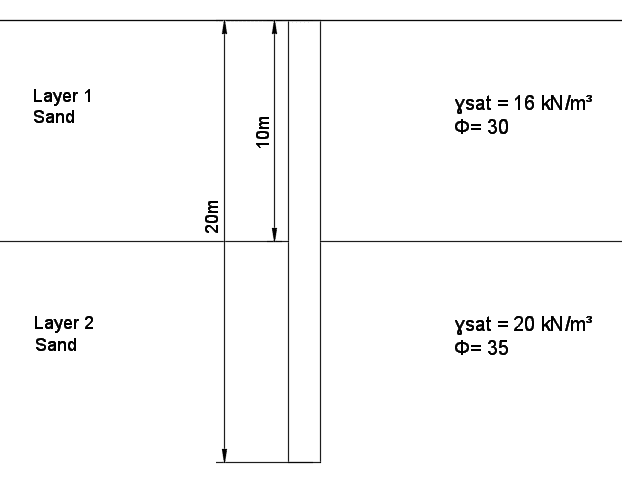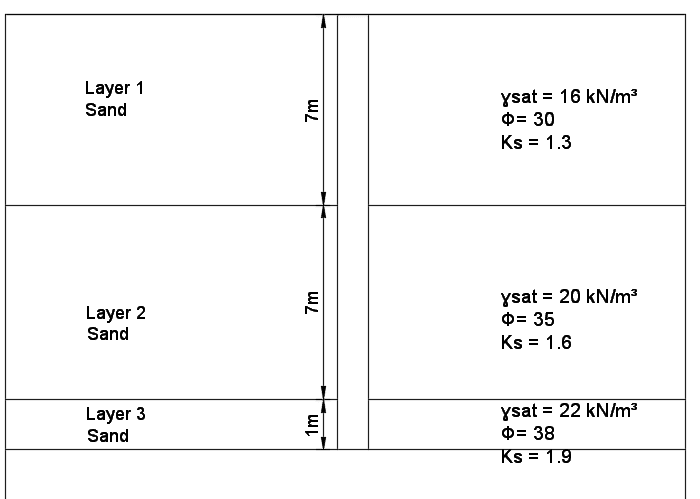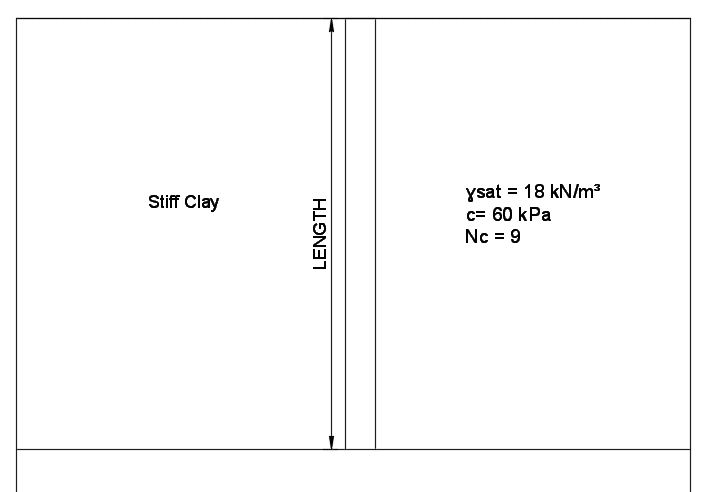Design Example to BS EN 1997
Table of Contents
Pile Design to EC7
When the top soil is loose or soft, the load of the structure can be transferred to a much competent layer (hard rock) which can be found much deeper in the soil. This article will go over examples of single pile design of driven and bored piles.
Example 1: Driven pile in Sand
A concrete pile, 600mm diameter pile was driven into sand to a depth of 20m. The first 10m of soil is loose sand with a density of 16 kN/m3 , followed by 10m of medium dense sand with a density of 20 kN/m3. The average internal friction is 30 and 35 for the loose sand and medium sand respectively.

Determine the following:
- the ultimate bearing capacity of the pile
- the allowable load with a factor of safety 2.5
Skin resistance of sand = fp = q0Ks tan\(\delta\)
In soil, Ks and \(\delta\) are constant, and q0 linearly increases with the pile depth.
fp = (0.5L\(\gamma\))Kstan\(\delta\)
The ultimate bearing capacity can be determined from the equation below:
Qu = Qdn + Qp
= (Nq x q) AB + (L x \(\gamma\)/2 Ks tan \(\gamma\))As
where AB is the base area of the pile, and As the surface area of the pile.
The bearing capacity is defined below:
Qdn = Nq . q . R2. \(\pi\)
For \(\theta\) = 35 and L/d = 20/0.6 = 33.3
Nq = 50 (refer to graph and interpolate to obtain value for Nq)
Effective normal stress at the base is
q = \(\gamma\)L = 16 x 10 + 18 x 10 = 340 kN/m2
The bearing capacity is
Qdn = R2 .\(\pi\)Nq.q
=(0.6/2)2 x \(\pi\) x 50 x 340
= 4800 kN
Qp = (L\(\gamma\)/2 Ks tan \(\delta\))(2R.\(\pi\))L
Ks = 1, \(\delta\) = 2/3\(\phi\) = 23 for \(\phi\) = 35 and 20 for \(\phi\) = 30
The skin resistance force, the load supported by the skin resistance, is
Qp = ((10 x 16)/2 x 1 x tan20 x (2 x 0.6 x \(\pi\)) x 10 +(10 x 18)/2 x 1 x tan23) (2 x 0.6 x \(\pi\)) x 10 = 1270 kN
With a factor of safety 2.5, the allowable load is
Qa = Qu/2.5 = (4800 + 1270)/2..5 = 2428 kN
Example 2: Driven pile in soil with water table
A concrete pile, 450mm diameter pile was driven into sand to a depth of 15m. The first 7m of soil is loose sand with a density of 16 kN/m3 , followed by 7m of medium dense sand with a density of 20 kN/m3. This was followed by another layer of 1m with a density of 22 kN/m3.

- Pile soil friction is \(\delta = 3/4\)
- Ks = 1.3, Ks = 1.6 and Ks = 1.9 for the layers respectively
- the allowable load with a factor of safety 2.5
Example 3: Driven pile in clay soil with water table
A concrete pile, 300mm diameter pile is required to support a load of 250 kN with a factor of safety of 2.5. The soil layer consists of stiff clay c=60 kPa and \(\gamma_{sat}\) = 18 kN/m3. The ground water level is at ground surface. Determine the length of the pile.


This Post Has One Comment
Good write up